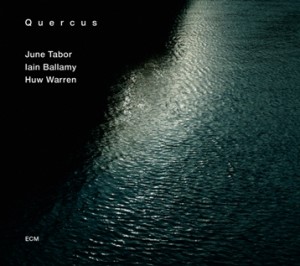The CDs awaiting review are piling up on all my indoor horizontal surfaces, the way the snow was drifting outside the door a short while ago. There’s only one thing to do with drifting snow or gathering CDs – clear a path. I came up with a nice handful of recordings that all approach traditional music in various ways. So here’s a look at some acoustic music from Quebec, Scottish music on fiddle and cello, Irish fiddle music from Chicago and beyond, and a superb jazzy take on some songs old and new from Scotland, England, Ireland and America.
De Temps Antan’s: Ce Monde Ici-Bas
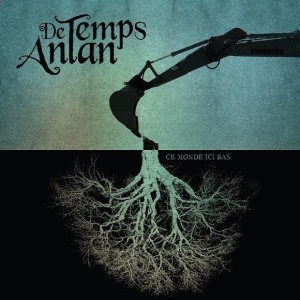 I haven’t yet discovered a Quebecois folk band that I don’t like, but De Temps Antan holds a special appeal. They’re extremely close to their roots and yet wildly adventurous, at once ancient-sounding and ultra-modern. I knew that guitarist Éric Beaudry had played with the supergroup La Bottine Souriante because I saw him play in both bands when De Temps Antan opened for La Bottine in Vancouver, Canada, a few years ago. (He’s also a member of Celtic Fiddle Festival with Kevin Burke, Christian Lemaître and Ged Foley.) But it turns out that the other two members of this acoustic power trio – fiddler André Brunet and accordionist Pierre-Luc Dupuis – have played and toured the world’s biggest stages with LBS as well. That may be why as a trio the play with such power and finesse.
I haven’t yet discovered a Quebecois folk band that I don’t like, but De Temps Antan holds a special appeal. They’re extremely close to their roots and yet wildly adventurous, at once ancient-sounding and ultra-modern. I knew that guitarist Éric Beaudry had played with the supergroup La Bottine Souriante because I saw him play in both bands when De Temps Antan opened for La Bottine in Vancouver, Canada, a few years ago. (He’s also a member of Celtic Fiddle Festival with Kevin Burke, Christian Lemaître and Ged Foley.) But it turns out that the other two members of this acoustic power trio – fiddler André Brunet and accordionist Pierre-Luc Dupuis – have played and toured the world’s biggest stages with LBS as well. That may be why as a trio the play with such power and finesse.
I identified each of these fellows with just one instrument, but they all play more than that, and they all contribute pieds, the foot percussion that’s unique to the music of Quebec. You’ll hear Dupuis on the jaw harp at the opening of this number, the first track on Ce Monde Ici-Bas called “Mépriseuse de Carçons.” It’s a traditional drinking song arranged by Dupuis:
The group’s name, for those of you not fluent in French, is pronounced something like “duh ta-zawn-TAWN,” which is a pun that can mean “From Time to Time” and also “From the Olden Times.” And the album title means “The Life Down Below,” which explains the striking artwork on the CD case. Those roots down under the ground are invisible to our eyes, but they’re big and strong. Kind of like this music.
The three principals are joined by several guests on this outing, most notably by singer (and cellist) Jorane, who provides atmospheric vocals on the lovely traditional ballad “Adieu donc cher coeur”; and by Louis Michot, singer and fiddler for the psychedelic Cajun band Lost Bayou Ramblers on the traditional emigration folksong “L’América.” He sings lead on call-and-response vocals, plays some nice fiddle duets with Brunet, and joins in some absolutely hair-raising multi-part vocal harmonies on this song, my favorite on the album. I also particularly like the swirling contemporary song “Jolie et Maquillée” by Richard Arpin. Beaudry plays some bluesy slide bouzouki licks on the intro to “Adieu donc cher coeur” by Quebec singer-songwriter David Marin. Dupuis plays some superb harmonica in unison with Brunet’s fiddle on two of the three reels in the medley “Les 3 archets,” and Brunet contributes a couple of very nice tunes, the “Valse St. Sévère” and the evocative closer, “Matin d’Hiver” or “Winter Morning.” There’s not a dull moment on this disc.
(L-A be, 2013)
De Temps Antan’s Les Habits du Papier
Speaking of bluesy slide bouzouki (as I was in the above review of De Temps 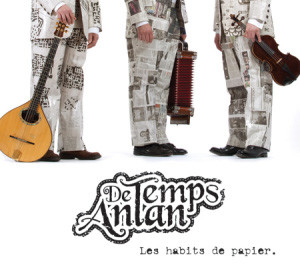 Antan’s Ce Monde Ici-Bas), it shows up again to great effect on the group’s 2010 release Les Habits du Papier. It’s on the similarly bluesy “Dominic à Marcel,” a very rootsy arrangement of a traditional song, the three singers accompanied for the most part only by pieds and that bouzouki, in the able hands of Éric Beaudry. Toward the end André Brunet and Pierre-Luc Dupuis join in on violin and harmonica, respectively, which only enhance the song’s rustic feel.
Antan’s Ce Monde Ici-Bas), it shows up again to great effect on the group’s 2010 release Les Habits du Papier. It’s on the similarly bluesy “Dominic à Marcel,” a very rootsy arrangement of a traditional song, the three singers accompanied for the most part only by pieds and that bouzouki, in the able hands of Éric Beaudry. Toward the end André Brunet and Pierre-Luc Dupuis join in on violin and harmonica, respectively, which only enhance the song’s rustic feel.
As is fairly common with the sophomore outing of a band, be it folk, rock or something else, Les Habits is a pretty focused collection of tunes and songs. The music is mostly made by just these three musicians, with fewer guest musicians than on their latest. But it’s brimming with creativity, as they trot out all the best bits in their bag of tricks. That includes the opening verse done entirely in mouth music and pieds on the first track, “La turlutte du rotoculteur,” or “Rototiller jig.” You can see a fine performance of it in this official video:
They give another song a lengthy a capella treatment, the exciting “Grand Amuseur de Filles,” which is the next-to-last of 13 tracks on this generous album. The first stanza of each chorus is done in three-part harmony, at which these gentlemen excel. Other standouts include “Roma au Lac Bell,” a set of three instrumental reels, two trad and one by M Brunet; and “Pétipétan,” also traditional, which sounds like one of those nonsense songs for children that also show up in Cajun music; “La Maison Renfoncée” which itself sounds much like a Cajun song, if Cajun songs featured call-and-response vocals and foot percussion; and finally, the closing track, the pensive “La Ruisseau Français,” which features guitar, fiddle and accordion in turn, and eventually turns into a more upbeat, reel-like tune.
Les Habits du Papier is yet another superb and moving recording from Quebec’s premiere acoustic power trio.
(L-A be, 2010)
Alasdair Fraser and Natalie Haas’s Abundance
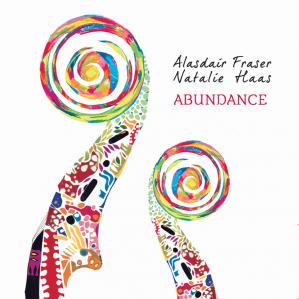 Scottish fiddler Alasdair Fraser and American cellist Natalie Haas have released their fourth album Abundance on Fraser’s Culburnie label. It is an impressive addition to their catalog and an entertaining tour through some of the many possible settings for Celtic-style music – strict duets through full-band arrangements, traditional Scottish to chamber folk to full-on world music.
Scottish fiddler Alasdair Fraser and American cellist Natalie Haas have released their fourth album Abundance on Fraser’s Culburnie label. It is an impressive addition to their catalog and an entertaining tour through some of the many possible settings for Celtic-style music – strict duets through full-band arrangements, traditional Scottish to chamber folk to full-on world music.
Fraser, of course, is one of the best-known (and best) Scottish fiddlers, and his Culburnie label has become one of the most critically acclaimed sources of Scottish folk music. Haas is a member of the burgeoning young generation of musicians who are following in the footsteps of pioneers like Mike Marshall, Darrol Anger, Bruce Molsky, Bela Fleck and others, honoring and expanding the legacy of traditional Anglo-Celtic-American music. Some of them join Fraser and Haas on a few of this disc’s generous 16 tracks, including bassist Corey DiMario and fiddler Brittany Haas of the groundbreaking Americana ensemble Crooked Still; multi-talented Hanneke Cassel on piano; trumpeter Kai Welch (Abigail Washburn, Wu Force), and percussionist Stefan Amidon.
In fact Abundance is bookended by big, energetic full-band numbers: First “The Corrie Man,” a suite of mostly traditional tunes including a strathspey, a “puirt à beul” or mouth music tune and a couple of pipe reels with a big brass ensemble, sprightly piano and some excellent mandolin from Dominick Leslie; and ending with Fraser’s “The Kelburn Brewer,” a very contemporary big band tune by Fraser.
Mostly, though, the album features the delightful interplay of these two musicians, either as a duo or with a few accompanists. My favorites are the more traditional pieces, including the strathspey-reel suite on the second track, with just Fraser and Haas plus DiMario on bass. Fraser tosses off a few bars of 16-note octave triplets during “The Old Reel,” accompanied by DiMario’s droning bowed bass, in a real show of fiddling pyrotechnics. Also catching my ear is “Keys To The Cellar,” another medley of traditional tunes with DiMario, Brittany Haas and that superb mandolinist again – Natalie and Corey play an excellent rhythmic accompaniment on the first melody, “Tarbolton Lodge.” “On The Wings Of A Skorrie” is a really superb slow reel by the late Michael Ferrie of Fiddlers’ Bid, with some textbook Scottish bowing from Fraser and multi-tracked accompaniment by Haas on the cello.
Also not to be missed is the diverting suite of contemporary tunes in several styles by Fraser, “Connie’s Suite,” that includes a slow reel, a waltz, a jig, a strathspey-reel blend played in a Gypsy jazz mode, and a world-music style reel called “Ouagoudougou Boogie” with African percussion and kalimbas, also known as mbira or thumb-piano. Here’s a live performance of that tune by just the two of them:
This fourth collaboration between Fraser and Haas is every bit a meeting of equals, as the old master and the young prodigy bring out the best in each other. Beautiful sleeve design and fine liner notes complete the package.
(Culburnie, 2014)
Liz Carroll: On The Off Beat
I’m certain that if you’re reading this review you don’t need to be told all 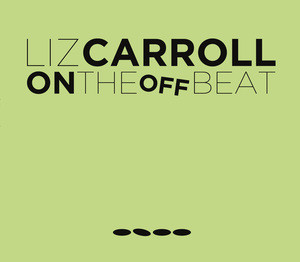 about Liz Carroll, but she’s so amazing I aim to tell you, anyway. She has been receiving awards and honors for her Irish-style fiddling since she won the All-Ireland under-18 championship in 1974 and the senior championship the very next year. Born in Chicago to Irish parents, she has made numerous recordings and toured as a solo artist, as a duo with Irish guitarist John Doyle, with the trio Trian, with the String Sisters, and now as another trio with Seán Óg Graham (guitar) and Trevor Hutchinson (bass) behind her latest release, On The Off Beat. She received the National Heritage Fellowship award in 1994, is the first Irish-American traditional musician nominated for a Grammy (for Double Play with Doyle in 2009), and in 2011 became the first American-born composer to be honored with Ireland’s top traditional music prize, the Cumadóir TG4.
about Liz Carroll, but she’s so amazing I aim to tell you, anyway. She has been receiving awards and honors for her Irish-style fiddling since she won the All-Ireland under-18 championship in 1974 and the senior championship the very next year. Born in Chicago to Irish parents, she has made numerous recordings and toured as a solo artist, as a duo with Irish guitarist John Doyle, with the trio Trian, with the String Sisters, and now as another trio with Seán Óg Graham (guitar) and Trevor Hutchinson (bass) behind her latest release, On The Off Beat. She received the National Heritage Fellowship award in 1994, is the first Irish-American traditional musician nominated for a Grammy (for Double Play with Doyle in 2009), and in 2011 became the first American-born composer to be honored with Ireland’s top traditional music prize, the Cumadóir TG4.
Liz is almost as well-known and honored for her compositions as for her playing. The book of her works published in 2010, Collected, is in its second printing. In performance, her down-to-earth personality belies the beauty and casual virtuosity of her playing.
You can hear plenty of that playing on On The Off Beat, named for one of two tunes on the second track which she refers to in the liner notes as “A three-part, 7/8 romp.” It has a driving Balkan sound to it, as does the tune it’s paired with, “The Fruit And The Snoot,” and she’s abetted by Winifred Horan (Solas) on fiddle, Natalie Haas on cello and Catriona McKay on harp, all of whom give a full big-band sound.
Here’s an audio-only version on YouTube:
That gang also plays on a couple of other tracks, the lovely slow march “Never Far Away” and the set of “Liam Childs/Balkin’ Balkan/The E-B-E Reel.” Liz has a few other guests on this disc of 12 tunes and sets including Keith Murphy playing piano on the engaging set “The Wolf’/The Duck” and Seamus Egan (the disc’s producer) on mandolin, but the core trio plays most of the music.
My favorites are the fourth track, a three-tune set the middle of which, “Fiddle Heaven,” is dedicated to the late, great Jerry Holland of Cape Breton Island (who I saw with Liz there in one of the most memorable concerts of my life); and the sixth, which pairs the lovely slow reel “Jerome Lacy” with “The Rogue’s Reel.” Graham’s picking and Hutchinson’s bass on this one are both sublime and perfectly complementary to Liz’s expressive fiddling.
The photo on the back of the CD sleeve says it all: The focus is on the fiddle, which is as it should be. On The Off Beat is another excellent set of fiddle tunes from Liz Carroll.
(self-released, 2013)
June Tabor, Iain Ballamy & Huw Warren: Quercus
In a world filled with young divas and wannabes whose role models are the imitators of Whitney Houston’s double-barreled melisma and the manufactured pop and hip-hop princesses who can’t sing without auto-tune, it’s good to know that there are still some real singers like June Tabor. Like an actor trained in classic Shakespearean theater techniques, Tabor is capable of illuminating myriad emotions within a song without beating you over the head with them. Her voice, a rich contralto with complex overtones, is instantly recognizable whether she’s singing a centuries-old folk song, a mid-20th-century love song or a modern pop song or hymn.
That range is on full display on this intriguing project, which pairs Tabor with a couple of jazz musicians, pianist Huw Warren and saxophonist Iain Bellamy. Tabor is best known as an interpreter of traditional British folk song – possibly the best – but she’s capable of applying her interpretive skills to all manor of song. She does that here, not as a jazz singer, but as an interpreter, finding the heart of these songs. Bellamy and Warren one moment are accompanying Tabor, providing a textural bed for her vocals, and the next are off on flights of improvisation that add their own interpretations and musical commentary to the tunes.
The piano and tenor sax twine about each other like the spring flowers in their lyrical accompaniment to “The Lads In Their Hundreds,” a selection from A.E. Housman’s lyrical but deeply tragic 1896 song cycle “A Shropshire Lad.” And the two positively frolic through the fields and forests of Shakespeare’s sonnet “Come Away Death,” as though reflecting the stark yet joyous circle that are life and death, living and dying. Their accompaniment is fairly straightforward in the very traditional Irish ballad “As I Roved Out,” which Tabor has recorded at least once before, long ago. The introductory section of “Near But Far Away” suggests the diamonds of reflected sunlight on the surface of the ocean, before the song gives way to somber verses of untrue love.
The high points of the album for me are the first and last tracks. The last surprised me. It’s a profound love song and also a hymn, set to a simple tune, written by the former Benedictine monk Gregory Norbet. Tabor sublimely captures the varying shades of meaning in the lyric that references grey wintery roads and sunlit days and the vastness of “forever” against which only love holds its small candle. Take a listen, and note the subtle colors Warren and Bellamy lend to the song, particularly in the harmonies in the improvised introductory section. Oh, and do note that it was recorded live with no overdubs, as was this entire project.
And the album opens with a similarly sublime version of Robert Burns’s “Lassie Lie Near Me.” There’s a moment in the final chorus when Tabor’s dusky voice and the closely modulated tone of Bellamy’s saxophone are perfectly in sync. “Near me, near me / Lassie Lie near me / Lang has thou lain thy lane / Lassie lie near me,” she sings, and in the first three beats of that third line of the quatrain, “Lang hast though,” voice and instrument go step-by-step down the scale. It’s not a showy moment, but one emblematic of the deep empathy and clarity that define this date. June Tabor has nothing left to prove, but that doesn’t mean that she doesn’t still give everything to every song that she approaches, and nearly every moment on this recording sees her two collaborators honoring that spirit with their own best.
(ECM, 2013)

